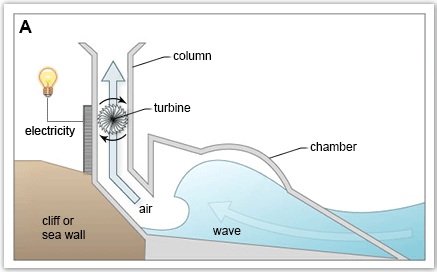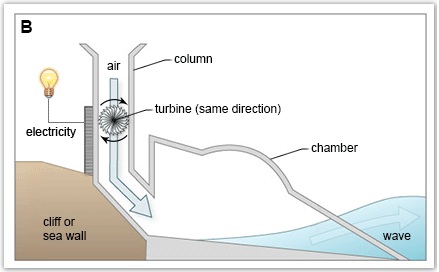You should spend about 20 minutes on this task.
The diagrams show a structure that is used to generate electricity from wave power. Summarise the information by selecting and reporting the main features, and make comparisons where relevant.
Write at least 150 words.


Sample Answer 1
The diagrams show the structure and processes of generating electricity from wave power. As is observed from the presented illustration, the wave is used to produce the electricity and both the tide and ebb of the structure are used to rotate a turbine to produce the electricity.
According to the given pictorial, the electricity-producing machine works in two ways. Firstly, the structure is placed near a sea so that the wave water gets inside the chamber, creating an air pressure that would rotate the turbine inside a column. The rotation of the turbine produces electricity which is stored in the cells, and this electricity can be passed and used. The whole structure is placed near the sea, adjacent to a cliff or sea wall.
The second illustration depicts how electricity can be produced using the ebb tide of the sea. During the ebb, the water gets off the chamber, and the air pressure is created again from the opposite direction, which rotates the turbine. The rotation of the turbine produces electricity and supplies it to storage.
In summary, the electricity can be produced using a structure near the sea, and both the tide and the ebb-tide are used to rotate the turbine to produce the electricity.
Sample Answer 2
The charts illustrate how electricity is produced from the sea tide and ebb using a structure near the seashore. This edifice is a man-made tool that produces electricity, thanks to the movement of the sea waves.
As can be seen, the process begins with the arrival of the wave, and it finishes when the ebb happens. As the first diagram suggests, sea waves enter inside the chamber of the structure during the tide, and then the force of the wave permits a powerful movement of the air inside a column in which a turbine is collocated. Thanks to the activity of the air, the turbine starts to rotate faster and this rotation is used to generate electricity.
Looking further at the second diagram, the turbine produces electricity even when the waves move away from the shore during the ebb. When the wave turns back, it creates an inverse movement of the air, which permits the movement of the turbine, which is the power source for generating electricity.
[Written by – Simone]
